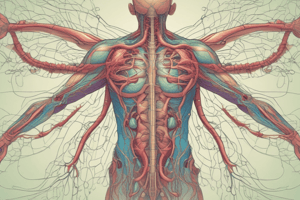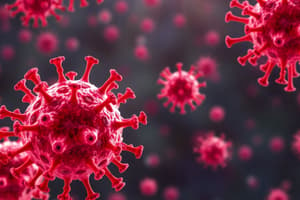Podcast
Questions and Answers
What is lymph?
What is lymph?
Lymph is excess fluid and proteins carried by lymphatic vessels.
Proteins secreted by natural killer cells that create holes in the target cell membrane are called:
Proteins secreted by natural killer cells that create holes in the target cell membrane are called:
- lysosomes
- pyrogens
- granzymes
- perforins (correct)
In a day, what volume of fluid leaves the arteriolar end of capillaries throughout the body?
In a day, what volume of fluid leaves the arteriolar end of capillaries throughout the body?
- 3L
- 5L
- 17L (correct)
- 20L
Which of the following cell types IS NOT targeted by natural killer cells?
Which of the following cell types IS NOT targeted by natural killer cells?
Approximately what volume of fluid enters the lymphatic vessels every day?
Approximately what volume of fluid enters the lymphatic vessels every day?
Which of the following statements about fever is FALSE?
Which of the following statements about fever is FALSE?
What is the main difference between interstitial fluid and lymph?
What is the main difference between interstitial fluid and lymph?
Lymph is prevented from flowing backwards by __________.
Lymph is prevented from flowing backwards by __________.
Tissue can be injured by:
Tissue can be injured by:
Match the following immune system terms with their descriptions:
Match the following immune system terms with their descriptions:
The primary function of the inflammation process is to:
The primary function of the inflammation process is to:
Lymphocytes are a type of __________.
Lymphocytes are a type of __________.
The bloodstream and lymphatic vessels form separate circuits.
The bloodstream and lymphatic vessels form separate circuits.
Which of the following statements about phagocytes is FALSE?
Which of the following statements about phagocytes is FALSE?
Study Notes
Immune and Lymphatic Systems
Lymph
- Lymph is a fluid that forms in the interstitial space and enters the lymphatic vessels
- Approximately 3L of fluid enters the lymphatic vessels every day
- Lymph has a similar composition to plasma
- Lymph is prevented from flowing backwards by valves and lymph nodes
Lymphatic Vessels
- Lymphatic vessels become smaller as they move towards the heart
- Lymphatic vessels are prevented from flowing backwards by valves
- The distribution of lymphatic vessels and drainage of lymph is asymmetrical
- The right upper torso, arm, and right side of the head drain into the right lymphatic duct
Lymphoid Organs
- Lymphoid organs include the spleen, tonsils, Peyer's patches, thymus gland, and appendix
- The spleen is located in the upper left abdominal quadrant, posterior to the stomach
- The thymus gland is located in the superior mediastinum, posterior to the sternum
- Lymphoid organs are responsible for the production and maturation of immune cells
Immune System Introduction
- The immune system has innate and adaptive defences
- Innate defences are non-specific and provide immediate protection against infection
- Adaptive defences are specific and provide long-term immunity against infection
- The immune system has three lines of defence against infection: skin and mucous membranes, phagocytes and natural killer cells, and B and T lymphocytes
First Line of Defence
- The skin and mucous membranes provide a physical barrier against infection
- The skin and mucous membranes also produce antimicrobial proteins and acids that inhibit the growth of microorganisms
- Sweat and tears also contain antimicrobial proteins and acids
- The skin and mucous membranes are the first line of defence against infection
Second Line of Defence
- Phagocytes and natural killer cells provide the second line of defence against infection
- Phagocytes engulf and digest pathogenic microorganisms using acids and enzymes
- Natural killer cells release proteins that create holes in the target cell membrane
- Phagocytes and natural killer cells work together to eliminate pathogenic microorganisms from the body
Third Line of Defence
-
The third line of defence against infection is adaptive and specific
-
The third line of defence involves the activation of B and T lymphocytes
-
B lymphocytes produce antibodies, which bind to antigens, marking them for destruction
-
T lymphocytes directly attack and destroy infected cells
-
The third line of defence provides long-term immunity against infection### Antibodies and Antigens
-
Antibodies bind to specific antigens.
-
Antibodies are Y-shaped proteins produced by plasma cells.
-
Antibodies are found in the blood plasma and other body fluids.
-
Antigens are substances (often proteins) that stimulate an immune response.
-
Antigens are the part/s of a pathogen recognised by the immune system.
Plasma Cells and Antibody Production
- Plasma cells produce antibodies.
- Plasma cells are responsible for producing a large amount of antibodies during an immune response.
Immune Response
- The primary immune response is slower and produces fewer antibodies.
- The secondary immune response is faster and produces more antibodies and memory B cells.
- The secondary immune response is to the same antigen as the primary response.
Mechanisms of Antibody Protection
- Agglutination: Antibodies help to clump together antigens, making it easier for other immune cells to remove them.
- Neutralisation: Antibodies bind to antigens, preventing them from entering host cells.
- Phagocytosis: Antibodies mark antigens for destruction by other immune cells.
- Precipitation: Antibodies bind to antigens, causing them to precipitate out of solution.
Immunity
- Active immunity is developed when an individual is vaccinated against a disease or infected with a pathogen.
- Passive immunity is developed when an individual receives antibodies or immune cells from another source.
- Active artificially acquired immunity is developed when an individual is vaccinated against a disease.
- Natural immunity is developed when an individual is infected with a pathogen.
Cell-Mediated Immunity
- Cytotoxic T cells: directly kill infected cells.
- Helper T cells: assist in the activation of other immune cells.
- Macrophage/APC: present antigens to T cells.
- Memory T cells: remember specific antigens and respond quickly to future infections.
- Regulatory T cells: regulate the immune response to prevent overactivation.
Immune Functions
- Cytokines: chemical messengers that activate the immune system.
- B lymphocytes: produce antibodies and respond to antigens.
- T lymphocytes: directly kill infected cells or assist in the activation of other immune cells.
- Memory cells: remember specific antigens and respond quickly to future infections.
- Plasma cells: produce large amounts of antibodies during an immune response.
- Cytotoxic T cells: directly kill infected cells.
- Helper T lymphocytes: assist in the activation of other immune cells.
- Antibodies: bind to specific antigens and mark them for destruction.
- Natural killer cells: directly kill infected cells and tumour cells.
- Macrophages: present antigens to T cells and engulf foreign particles.
- Neutrophils: engulf foreign particles and bacteria.
Studying That Suits You
Use AI to generate personalized quizzes and flashcards to suit your learning preferences.
Description
Pre-learning quiz on immune and lymphatic systems, covering capillary microcirculation, hydrostatic and osmotic pressure, and lymph composition.




